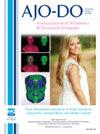A cone-beam computed tomography study of deformational plagiocephaly and its influence on condylar position and menton deviation in subjects with Class I skeletal pattern
IF 2.7
2区 医学
Q1 DENTISTRY, ORAL SURGERY & MEDICINE
American Journal of Orthodontics and Dentofacial Orthopedics
Pub Date : 2025-02-01
DOI:10.1016/j.ajodo.2024.09.010
引用次数: 0
Abstract
Introduction
This study aimed to explore the distribution of deformational plagiocephaly in subjects with Class I skeletal pattern and the relationships of cranial vault asymmetry with menton deviation, condylar anteroposterior (AP) position and condylar angulation using cone-beam computed tomography images.
Methods
Approximately 135 pretreatment records of patients with skeletal Class I growth patterns from the University of Detroit Mercy were examined using Anatomage Invivo6 software. The midsagittal plane constructed by nasion, incisive foramen, and basion was used to evaluate the asymmetry of the cranium vault, condyles, and menton deviation. For each patient, the radiographic cranial vault asymmetry (RCVA) was calculated and compared against condylar and chin measurements: the horizontal condylar angle, AP positions of the condyles, and menton deviation.
Results
The Pearson correlation showed no direct correlation between RCVA and the mandibular variables (menton deviation and condylar measurements). The only mandibular variable that showed interaction with RCVA was the AP position discrepancy between the right and left condyles.
Conclusions
The severity of cranial vault asymmetry did not correlate to the asymmetry of the horizontal condylar angle, AP condylar position, and chin deviation. A tendency toward a relation between cranial asymmetry and AP positions of right and left condyles was observed.
锥形束计算机断层扫描研究畸形性颅底及其对 I 类骨骼模式受试者髁状突位置和门牙偏差的影响。
简介本研究旨在利用锥形束计算机断层扫描图像,探讨 I 类骨骼模式受试者畸形性长头畸形的分布情况,以及颅顶不对称与门静脉偏移、髁突前胸(AP)位置和髁突角度的关系:使用 Anatomage Invivo6 软件检查了底特律梅西大学约 135 名骨骼 I 类生长模式患者的治疗记录。由鼻翼、切孔和基底构成的中矢状面用于评估颅顶、髁突和门锥偏离的不对称情况。对每位患者的颅穹隆不对称(RCVA)进行计算,并与髁突和下颏的测量结果进行比较:水平髁突角、髁突的AP位置和门牙偏差:皮尔逊相关性显示,RCVA 与下颌变量(髁突偏差和髁突测量值)之间没有直接相关性。唯一显示与 RCVA 相互影响的下颌骨变量是左右髁突的 AP 位置差异:结论:颅穹不对称的严重程度与水平髁突角、AP髁突位置和颏偏的不对称程度无关。颅顶不对称与左右髁状突AP位置之间存在相关性。
本文章由计算机程序翻译,如有差异,请以英文原文为准。
求助全文
约1分钟内获得全文
求助全文
来源期刊
CiteScore
4.80
自引率
13.30%
发文量
432
审稿时长
66 days
期刊介绍:
Published for more than 100 years, the American Journal of Orthodontics and Dentofacial Orthopedics remains the leading orthodontic resource. It is the official publication of the American Association of Orthodontists, its constituent societies, the American Board of Orthodontics, and the College of Diplomates of the American Board of Orthodontics. Each month its readers have access to original peer-reviewed articles that examine all phases of orthodontic treatment. Illustrated throughout, the publication includes tables, color photographs, and statistical data. Coverage includes successful diagnostic procedures, imaging techniques, bracket and archwire materials, extraction and impaction concerns, orthognathic surgery, TMJ disorders, removable appliances, and adult therapy.

 求助内容:
求助内容: 应助结果提醒方式:
应助结果提醒方式:


